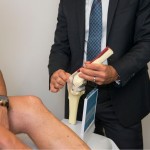
In recent times there has been a lot of interest around stems cells and their use as an answer to a wide number of medical conditions.
In my practice due to the excitement generated by successful application of stem cell therapy for the treatment of other conditions, patient’s will sometimes ask if the use of stem cell therapy is possible to treat their osteoarthritis.
What are mesenchymal stem cells?
Mesenchymal stem cells or “adult” stem cells have the potential to develop into any cell type in our body. They are “unspecialised” cells that are able to renew themselves by dividing through cell division, and in certain environments or conditions – they can be actuated to become cells that are tissue or organ specific.
In some organs like bone marrow, our stems cells are constantly repairing and replacing damaged or worn out tissue as they divide, but this isn’t the case for all our organs including the heart where they divide only under certain circumstances.
What conditions are currently treated successfully with stem cells?
Stem cell therapy has achieved great success in the treatment for bone marrow diseases as well as some blood and immune system conditions like childhood leukemia, and in some instances where the blood system is rebuilt after cancer treatments. They have also been used successfully in the treatment of eye injuries requiring grafting or tissue implants as the healing process utilises stem cells within the implanted tissue.
The use of stem cell procedures in the treatment of these conditions has proven success and they are regarded by the medical community as being safe and effective.
What about the use of stem cell therapy as a treatment for osteoarthritis (OA)?
In recent years the discovery of the ability to quite easily harvest mesenchymal stem cells from our own body fat has led to trials and research into the use of stem cell therapy in the treatment of many different medical conditions.
One of the main areas of focus has been the use of stem cells as a treatment option for OA.
Ongoing research and development continues to be conducted worldwide based around the efficacy of stem cell therapy for OA. While the research has delivered some potentially promising results, different treatment modalities are still in the experimental stage and evidence continues to be gathered as to which approach will provide us with a stem cell treatment for OA that is both effective and safe, like that achieved for other conditions.
Essentially the research undertaken is to clearly determine stem cell therapy as front line treatment for OA.
Is there currently any “proven results” stem cell therapy for OA and what is the cost?
Currently there are a number of stem cell therapy treatments available for sufferers of OA, but we are still waiting on evidence to determine whether any of the current available treatments are credible and will deliver results. At this time, all treatment options available are still considered “experimental” without supporting data and evidence.
Another consideration regarding stem cell treatments is a financial one as the treatments are not covered through health insurance and are generally expensive.
What are the options for management and treatment of OA?
OA is a chronic long term disease and treatment options vary dependent upon each individual. Currently there is no cure as such, but there are proven benefits to introducing long term symptom management principles that include:
- Management of your pain, stiffness and swelling symptoms.
There are a number of medications, cremes and injections that we have available that will assist with this including some over the counter analgesics through to injections by specialist doctors directly into the joint.
- Attaining improvement of your joints mobility and flexibility
This is best achieved through regular stretching of the joints. Yoga and tai chi have been proven to be a great way to manage joint stiffness and increase flexibility.
- Maintaining a healthy weight
Additional weight cause more stress on our hips, knees and ankles which are all weight-bearing joints and more susceptible to OA. Losing that excess weight often helps to reduce the pain from OA and importantly will help to limit further damage to your joints.
- Introduce regular exercise to your lifestyle
One of the proven methods to best manage OA is through moving! While we think if our joints are sore we should rest them, studies have shown that regular simple exercise activities such as walking will help reduce pain as well as assist in maintain a healthy weight.
Affected joints will also benefit from strengthening exercises that focus on building muscle around the joint.
Before undertaking any specific exercise programs to assist with the management of your OA, ensure you speak to your doctor to ascertain which exercises will be of most benefit and not exacerbate your symptoms.
When is it time for surgery to treat OA?
When your joint has been severely damaged and your ability to maintain your usual lifestyle is impacted, we may recommend you undertake joint replacement surgery.
This is the process in which your natural deteriorated joint is replaced by an artificial joint made of metal implants.
Joint replacement surgery is one of the most common and successful surgical procedures performed. With ongoing improvements in techniques and the development of superior artificial joints, results based on patient satisfaction ratings see this as still being the gold standard treatment for joints that are severely damaged by OA.
Is there a future for stem cell therapy as a front line treatment for OA?
Stem cells have shown enormous benefit in treating a range of diseases and injuries, but we still have a lot to learn about them. However, with the amount of focus worldwide being given to stem cells as a treatment for OA, we are hopeful that the research now being undertaken will bear fruit in the years to come and the use of stem cells as a reliable treatment will become a reality.


